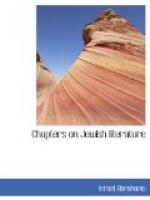The author of the “Branch of David,” David Cans, was born in Westphalia in about 1540. He was the first German Jew of his age to take real interest in the study of history. He was a man of scientific culture, corresponded with Kepler, and was a personal friend of Tycho Brahe. For the latter Cans made a German translation of parts of the Hebrew version of the Tables of Alfonso, originally compiled in 1260. Cans wrote works on mathematical and physical geography, and treatises on arithmetic and geometry. His history, “Branch of David,” was extremely popular. For a man of his scientific training it shows less critical power than might have been expected, but the German Jews did not begin to apply criticism to history till after the age of Mendelssohn. In one respect, however, the “Branch of David” displays the width of the author’s culture. Not only does he tell the history of the Jews, but in the second part of his work he gives an account of many lands and cities, especially of Bohemia and Prague, and adds a striking description of the secret courts (Vehmgerichte) of Westphalia.
It is hard to think that the authors of the “Chain of Tradition” and of the “Light of the Eyes” were contemporaries. Azariah di Rossi (1514-1588), the writer of the last mentioned book, was the founder of historical criticism among the Jews. Elias del Medigo (1463-1498) had led in the direction, but di Rossi’s work anticipated the methods, of the German school of “scientific” Jewish writers, who, at the beginning of the present century, applied scientific principles to the study of Jewish traditions. On the other hand, Gedaliah Ibn Yachya (1515-1587) was so utterly uncritical that his “Chain of Tradition” was nicknamed by Joseph Delmedigo the “Chain of Lies.” Gedaliah was a man of wealth, and he expended his means in the acquisition of books and in making journeys in search of sacred and profane knowledge. Yet Gedaliah made up in style for his lack of historical method. The “Chain of Tradition” is a picturesque and enthralling book, it is a warm and cheery retrospect, and even deserves to be called a prose epic. Besides, many of his statements that were wont to be treated as altogether unauthentic have been vindicated by later research. Azariah di Rossi, on the other hand, is immortalized by his spirit rather than his actual contributions to historical literature. He came of an ancient family said to have been carried to Rome by Titus, and lived in Ferrara, where, in 1574, he produced his “Light of the Eyes.” This is divided into three parts, the first devoted to general history, the second to the Letter of Aristeas, the third to the solution of several historical problems, all of which had been neglected by Jews and Christians alike. Azariah di Rossi was the first critic to open up true lines of research into the Hellenistic literature of the Jews of Alexandria. With him the true historical spirit once more descended on the Jewish genius.




